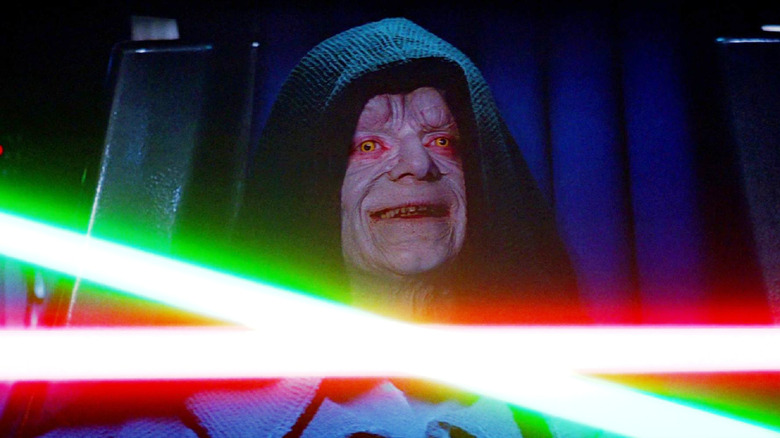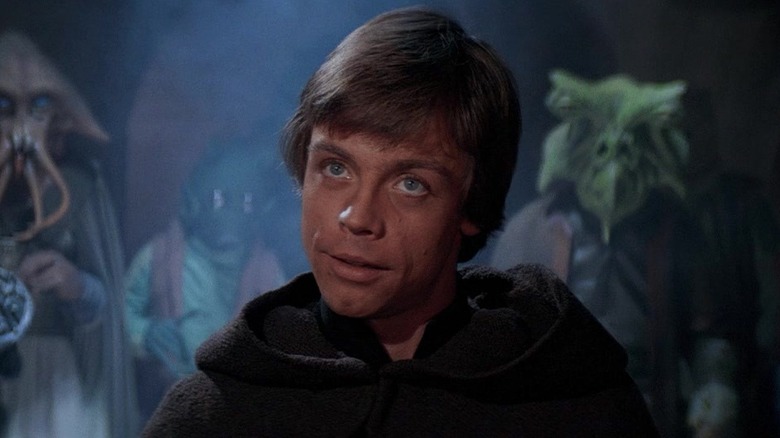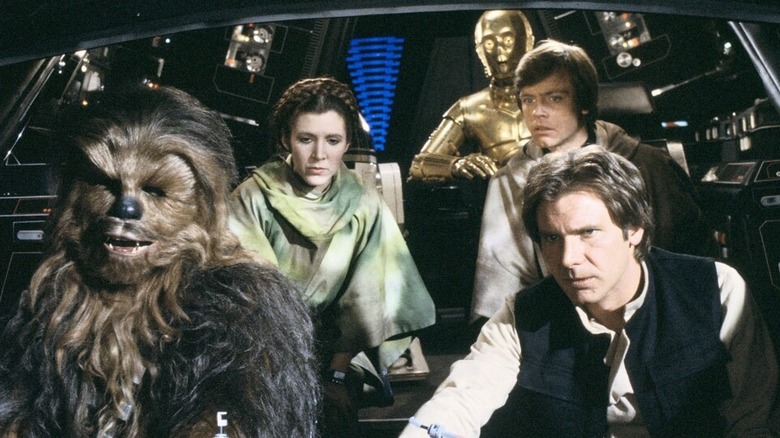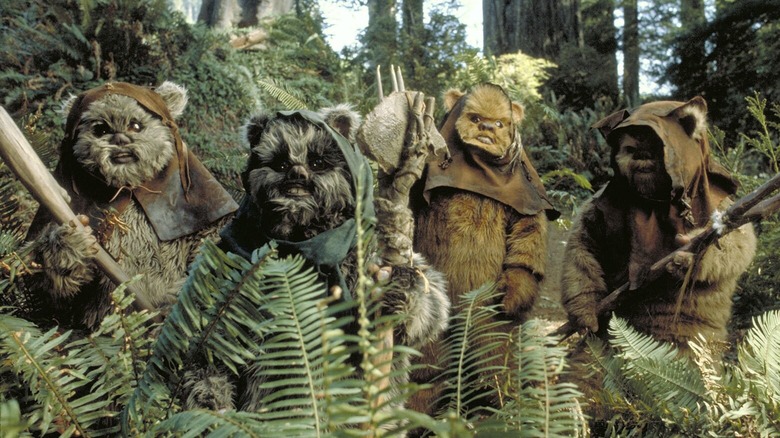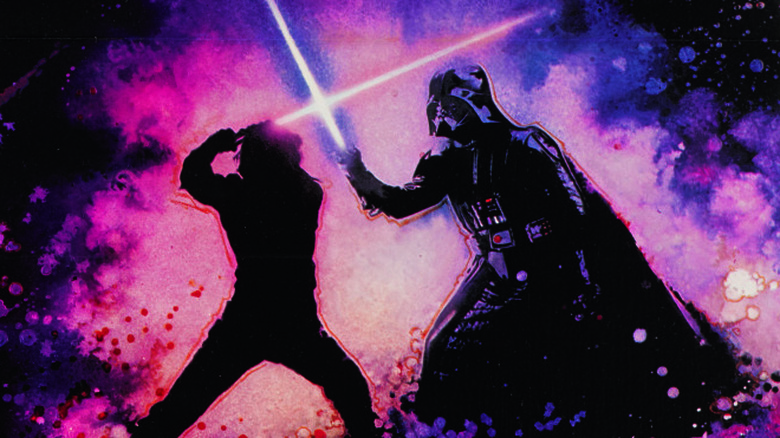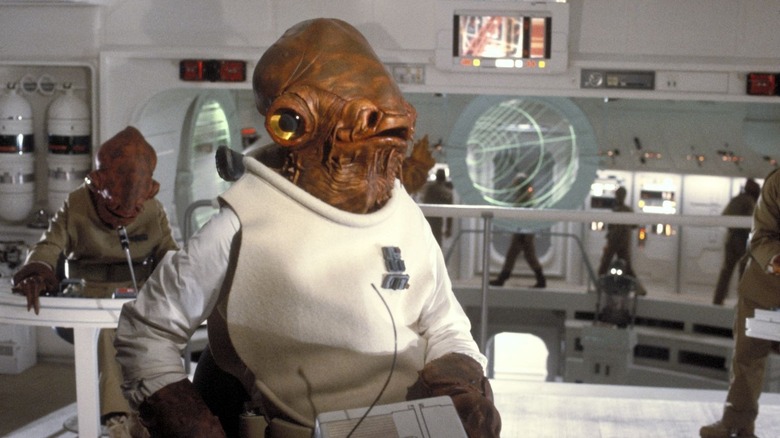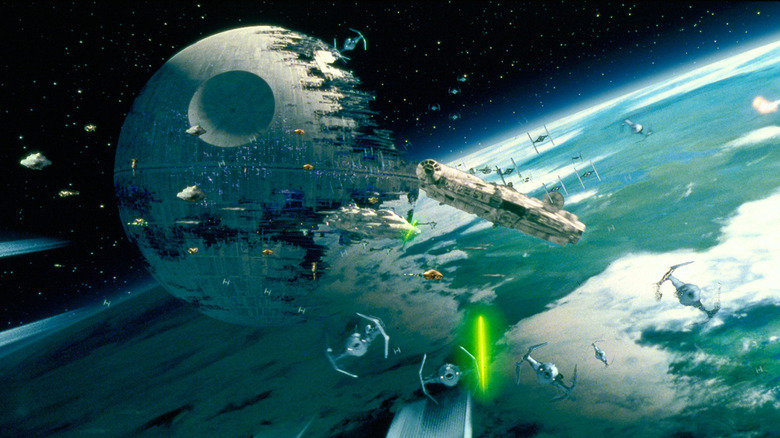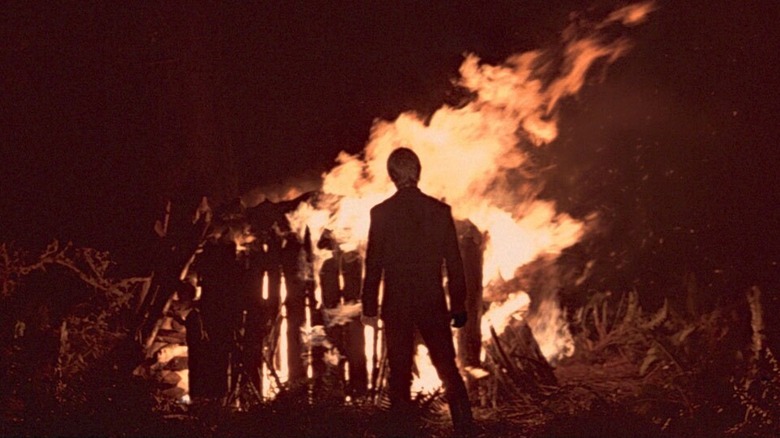Tales From The Box Office: Return Of The Jedi Gave Star Wars An Ending (And A New Beginning)
(Welcome to Tales from the Box Office, our column that examines box office miracles, disasters, and everything in between, as well as what we can learn from them.)
It is, by almost any measure, impossible to quantify just how much of an impact "Star Wars" had on popular culture when George Lucas introduced his galaxy to the masses in 1977. I myself have a mother who saw the original 17 times in a theater that summer. (I believe she'd make it 18, provided the chance.) It was the biggest movie of all time and took people by absolute surprise. Sequels were no guarantee back then but, in this case, Lucas had the chance to finish what he started, releasing "The Empire Strikes Back" in 1980, which left audiences with a pretty massive cliffhanger. All would be resolved in the summer of '83 when "Return of the Jedi" brought the original trilogy to a close.
"Episode VI" had a lot to accomplish, resolving that whole Darth Vader being Luke's father bombshell, the Rebellion conquering the Empire, turning Luke into the Jedi he was always destined to become, getting Han Solo out of that carbonite, and Han's well-they-won't-they romance with Princess Leia. Not to mention the fact that Lucas was, once again, going to self-finance and produce the movie just as he had done with "Empire" as a means to maintaining creative control. Even against a stacked deck, Lucas and the team he assembled pulled it together to bring "Star Wars" to an end. Or, at least a long enough ending to leave audiences hungry for more.
In honor of its 40th anniversary, we're looking back at "Return of the Jedi," how Lucas chose its director, how it measured up against the movies that came before it, what happened after its run in theaters was in the rearview mirror, and what lessons we can learn from it all these years later. Let's dig in, shall we?
The movie: Star Wars: Return of the Jedi
Much like with "Empire," George Lucas opted not to direct "Return of the Jedi" himself. So, the first thing he needed to do was get that director's chair filled. Ultimately, Richard Marquand ("Eye of the Needle") was chosen by Lucas to helm the finale of this epic trilogy. Of course, he was neither the first nor the only choice. David Lynch and David Cronenberg declined to direct and it was long rumored that Steven Spielberg was in the running, with Directors Guild of America rules getting in the way of him actually taking the gig. So it fell to Marquand.
Lucas, for his part, wanted a director who could "handle something this big" and someone who didn't think of "Star Wars" as " kid's junk." Marquand, however, had not done an effects-heavy picture before and Lucas was, as a result, on set a lot of the time. "It's like trying to direct 'King Lear' with Shakespeare in the room!" Marquand once said of the experience.
Marquand, for his part, liked to keep a fun vibe on set — or tried to anyway. Speaking with The ASC, the filmmaker explained that he had a pretty pragmatic way of looking at the job he was tasked with:
"You're not in a temple of art. This is show business. You're hoodwinking an audience. You've got this cheap three-ply door which is supposed to look like a monstrous golden metal thing and you're using gauzes and smoke and God knows what to make them think that they're in some magic fairytale place."
Han Solo returns
George Lucas was involved in writing the screenplay alongside Lawrence Kasdan, who co-wrote "Empire," with Richard Marquand on board as well. After kicking lots of ideas back and forth, Kasdan ultimately put all of those together in a screenplay. The story sees the Empire nearly finished with a second Death Star that the Rebel Alliance must destroy in order to save the galaxy. But first, Luke and his pals must save Han Solo from Jabba the Hutt, with Boba Fett delivering him to the crime lord on Tatooine in between films.
This was actually a bit of an issue, as Harrison Ford wasn't contractually obligated to appear in the sequels. The carbonite offered a possible way of killing off Han Solo and pressing on without him, if need be. But Ford was a huge star by this time, with "Raiders of the Lost Ark" hitting theaters in 1981. Ultimately, it was producer Howard Kazanjian who talked the actor into returning. As Kazanjian explained in 2010:
"I had just recently negotiated [Ford's] deal for 'Raiders of the Lost Ark' with Phil Gersh of the Gersh Agency. I called Phil who said he would speak with Harrison. When I called back again, Phil was on vacation. David, his son, took the call and we negotiated Harrison's deal. When Phil returned to the office several weeks later he called me back and said I had taken advantage of his son in the negotiations. I had not. But agents are agents."
Ford was not necessarily enthusiastic about it. Speaking to ABC, Ford somewhat famously said, "As a character, he was not so interesting to me. I thought he should have died in ['Return of the Jedi'] just to give it some bottom." Ford also quipped, "George didn't think there was any future in dead Han toys."
The Emperor and the Ewoks
Having the core cast return was key, yes, but the finale needed some new elements as well. Chief among them was bringing in the figure at the top of the food chain in the Empire. Identified only as The Emperor in "Return of the Jedi," Ian McDiarmid took on the role of the Sith who served as Darth Vader's master, who we now know as Sheev Palpatine. The masses wouldn't actually hear that name until "The Phantom Menace" hit theaters in 1999 though.
In 1983, it was merely the ominous Emperor finally showing his face, having briefly appeared as a hologram in "The Empire Strikes Back." This was our biggest of Big Bads; the figure that Luke and Vader could ultimately unite against. And, in the end, a figure that would go on to permeate and in some ways define "Star Wars" for decades to come.
Much of the film as we know it takes place on the forest moon of Endor, with the native Ewoks playing a key role in overthrowing the Empire. The tiny, adorable creatures have always been a love/hate thing for many fans. Originally, however, the plan was to have Wookiees assisting the Rebels. Why the change? The notion of primitive Wookiees didn't quite fit anymore, thanks to what we'd come to know through Chewbacca. Instead, we got an entirely new species that essentially boil down to deceptively cute murder bears. George Lucas explained his original plans in a Rolling Stone interview shortly after the film hit theaters:
"The idea was just a short Wookiee. In the original film, the giant end battle was the crux of the whole movie: a sort of primitive society overcoming this huge technological society. In the early versions of the script, those primitives were Wookiees."
Jedis don't take revenge
One of the biggest things that needed to be settled — right up until the movie was just about to debut in theaters — was the title. Originally, the script had it as "Revenge of the Jedi," which both Lawrence Kasdan and producer Howard Kazanjian felt was a stronger title. But George Lucas was going back and forth between "Revenge" and "Return" initially. Speaking in the 2004 documentary "Empire of Dreams," Kazanjian explained:
"George came to me and he said the title of 'Episode VI' is 'Return of the Jedi.' I said, 'I think it's a weak title.' He came back one or two days later and he says, 'We're calling it 'Revenge of the Jedi.”"
And so, all throughout the writing process, production, and even the early marketing, the film had "Revenge" in the title. Rather famously, a trailer was even released with that title and a small number of early posters with the name were made available to lucky fans. (Those original posters are now worth a fortune.) Lucas, however, decided to revert back to "Return" at the 11th hour. His reasoning? Jedis don't take revenge.
"Just before it got to the theaters, George came back and he said, 'I want to go back to 'Return of the Jedi,”" Kazanjian said in the documentary. "The logic behind that was, a Jedi does not take revenge." And so it was, the title was changed along with all of the marketing materials. It's power like this that Lucas was able to exercise because he was the moneyman funding the whole endeavor.
With the cast back, a new villain in place, a title settled on, and months of laborious, costly production in the rearview mirror, it was time to unleash the finale to the greatest cinematic saga in history to the masses.
The financial journey
Even though George Lucas self-financed the film, he maintained his distribution relationship with Fox, as it had been fruitful for both parties up to this point. One key difference this time around is that "Return of the Jedi" would be the first of the trilogy to release wide on its opening weekend, debuting in more than 1,000 theaters. For the sake of comparison, "A New Hope" opened in scarcely more than 40 theaters before catching on like wildfire, with "Empire" opening on a mere 126 screens.
"Return of the Jedi" hit theaters on Wednesday, May 25, 1983, six years to the day after "A New Hope" changed movies forever. On its opening day, the film pulled in a record $6.2 million, en route to a then-record-shattering $23 million three-day weekend haul and a $41 million total over the extended Memorial Day weekend stretch. It was a smash hit, as expected. The film stayed atop the charts for six of its first seven weeks of release, only briefly surrendering the crown to "Superman III" on its fourth weekend.
In the end, the trilogy finale brought in $375 million in its original run. But through the years, thanks to its various re-releases, that total has grown to over $482 million, including a trip back to the top five at the box office earlier this year. While that wasn't as much as "A New Hope" ($503 million first run/$775 million to date) or "Empire Strikes Back" ($400 million first run/$549 million to date), the film still earned 12 times its reported $33 million budget even before the re-releases in a theatrical landscape that was radically changed due to the success of the original "Star Wars." It was an unmitigated, massive win that cemented Lucas as a visionary mind. Perhaps most importantly, it left fans eternally wanting more.
Star Wars was no longer in theaters but never really gone
Not only were sequels not as much of a thing in 1983, but the idea of expanded universes to truly exploit a franchise was wildly uncommon. As such, when "Return of the Jedi" wrapped up its run, "Star Wars" was essentially over. But the world had encountered nothing quite like "Star Wars" before and the feverish hunger for more would ensure that a galaxy far, far away would continue in some form, even if it was beyond the big screen.
The following year, the made-for-TV movie "Caravan of Courage: An Ewok Adventure" aired on ABC, which was followed up by "Ewoks: The Battle for Endor" in 1985. Unlike "The Star Wars Holiday Special," these films would not be lost to time — you can stream them on Disney+! They would prove to be the tip of the iceberg that would attempt to satiate hungry fans who wanted more.
Those movies were aimed largely at younger viewers, but author Timothy Zahn stepped in to give fans the sequel they had dreamed of with his "Heir to the Empire" novel trilogy, beginning in 1991. These books all but invented the expanded universe that existed until Disney's purchase of Lucasfilm. Picking up a few years after the events of "Jedi," they gave us a new Big Bad in the form of Grand Admiral Thrawn (who, to this day, remains one of the most beloved characters created outside of the movies). These novels also provided fans more of what they craved. Much, much more would come in the years that followed.
Comics, more books, toys, video games, you name it, we got it. They all helped to fill the void until the "Special Editions" hit theaters in 1997, which bridged the gap until George Lucas eventually returned to make his prequel trilogy. Audiences turned up in droves to see "The Phantom Menace" in 1999, as a result of being downright starved for over a decade.
The lessons contained within
It's amazing to see just how much the media landscape has changed in the 40 years since "Return of the Jedi." Franchises now drive Hollywood almost completely, with the Marvel Cinematic Universe making full-on cinematic universes all the rage. A trilogy? Forget it! Multiple trilogies! Crossover films! TV spin-offs! That's more or less what's become of "Star Wars" since Disney bought Lucasfilm, for better or worse. For better? We've got stuff like "The Mandalorian" and "Andor." For worse? That's largely for the individual to decide and for fans to debate endlessly.
Fans will never go too long without "Star Wars" now. It's always going to be there in some very present way. That wasn't quite the case post-1983, where even the books had to be sought out very deliberately by extra-hungry fans. Say what you will about the prequels, but that was the brilliance of waiting a full 16 years to release "The Phantom Menace." By that point, audiences were so eager for new "Star Wars" that they flooded screenings of "Meet Joe Black" just to see the damn trailer.
Therein lies the biggest lesson Disney and other major corporations would do well to learn. If you let audiences have enough time to desire something and get excited about it, it's better in the long run. We saw that yet again with "The Force Awakens," which came out a decade after "Revenge of the Sith" and become one of the biggest movies ever. By contrast, the MCU has struggled in the aftermath of "Avengers: Endgame" to make it all feel as significant again.
Heck, we're even seeing anticipation build for a new "Star Wars" movie now that "The Rise of Skywalker" is nearly four years behind us. Had we gotten a new film in theaters in say, 2022? Who knows. The key thing is that "Return of the Jedi" was satisfying as an ending, but not so much that it killed the imaginations of fans who always knew the galaxy was large with much to explore.
